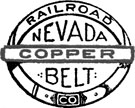Ludwig
In the 1860s, a German immigrant named John Ludwig located copper ore in the Singatse Range. A small amount of production was made from 1865 until 1868, and in 1881 Ludwig managed to finance a small smelter. Unfortunately it proved to be a failure and Ludwig went bankrupt. In 1907, the old Ludwig mine was purchased by the Nevada-Douglas Copper Company, who purchased the nearby Douglas and Casting mines the year before. The Company began significant development, and the camp of Morningstar was laid out below; by 1911 that camp took on the older Ludwig name.
Work began on the new Nevada Copper Belt Railroad in 1909, with the intent of connecting the copper mines scattered about the Singatse Range to the Southern Pacific in Wabuska, and rails finally reached Ludwig in October 1911. A grand celebration marked Ludwig's "Railroad Day" on December 29, 1911.
By 1912, several hundred people lived in Ludwig, a camp of sixty-five buildings including a school, hotel, store, and infirmary. Saloons and brothels appeared, too, but were located outside the proper townsite. The following year it peaked at 750, and in 1914 the Nevada-Douglas Company started work on a large leaching plant. The plant went into operation in 1917, but proved an expensive failure and closed the next year, and a decrease in mining thereafter led to Ludwig's decline. Passenger service on the NCB ended in 1919, with the tracks finally being placed out of service in 1933 (they were formally abandoned nine years later). Despite a small boost from gypsum mining in the 1920s and 30s, Ludwig soon joined the ranks of Nevada's many ghost towns.
































